International Practical Shooting Confederation
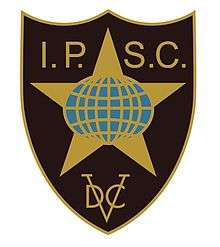 | |
| Motto |
"Diligentia, Vis, Celeritas" Latin for "precision, power, speed" |
|---|---|
| Formation | May 1976 |
| Headquarters | Oakville, Ontario, Canada |
Membership | 100 regions |
President | Nick Alexakos |
| Subsidiaries | International Range Officers Association |
| Website |
ipsc |
The International Practical Shooting Confederation (IPSC) is a shooting sport association based on the concept of practical shooting. Accuracy, power and speed are all required to achieve a maximum score. Competitions are shot both with pistol, revolver, shotgun and rifle, and competitors are divided into different divisions based on firearm and equipment features. While everyone in a division competes in the Overall category, there are also own separate categories for Lady (female competitors), Junior (under 18 years), Senior (over 50 years) and Super Senior (over 60 years).
The world championships are called World Shoots and are held for each of the disciplines, see:
Founding and organization
The sport of practical shooting originated from competitions in California in the 1950s with the goal of developing handgun skills for defensive use, but quickly evolved into a pure sport with little grounding in the original purpose. The sport soon expanded to Europe, Australia, South America and Africa.
IPSC was founded in May 1976 when practical shooting enthusiasts from around the world participated at a conference held in Columbia, Missouri, creating a constitution and establishing the rules governing the sport.[1][2] Jeff Cooper served as the first IPSC President.
Practical shooting is today a major international sport and emphasizes firearms safety highly. Through international rules concerning firearms, equipment and organizing of matches one tries to unite the three elements precision, power and speed, which is also found to be the motto of IPSC that is "Diligentia, Vis, Celeritas" (DVC), Latin for "precision, power, speed". Only full caliber firearms are used, i.e. for handguns 9x19 mm is the smallest caliber, and the competitors try to achieve most points in the shortest time possible.
While IPSC is an international organization, countries have their own organizations under the IPSC umbrella. For example, there is the United States Practical Shooting Association (USPSA) in the United States, the United Kingdom Practical Shooting Association (UKPSA) in the United Kingdom, and the South African Practical Shooting Association (SAPSA) in South Africa. There are currently 100 active IPSC regions.[3]
Minor and major
Power is a requirement in IPSC competition along with speed and accuracy, and is measured by the power factor, which is the momentum of the bullet as it's moving through the air. The power factor must exceed certain thresholds, and is calculated by measuring the bullet speed using a chronograph and measuring another of the competitors bullets on a weighing scale to find the bullet mass, thereafter calculating the power factor by the formula:
To measure the muzzle velocity the competitor's ammunition must be fired in the competitor's firearm, since velocities can vary slightly from one firearm to another. In for instance handgun competitions the ammunition must exceed 125 for Minor scoring, and at least 160 or 170 for Major scoring (depending on division). Extra scoring is not given for exceeding the threshold. A competitor declaring major, but who fails the threshold, have their score re-calculated at minor. A competitor who fails the threshold of minor is given a score of zero for the match.
The official unit used for the power factor is the imperial unit "kilo grain feet per second" (kgr·ft/s). "Grain feet per second" (gr·ft/s) can be obtained by measuring the mass in grain (gr) (7,000 to the pound) and velocity in feet per second (ft/s), but since their product yields a very large number it is common to multiply by a factor of 1⁄1000, obtaining the power factor in "kilo grain feet per second" instead.
The power factor can also be measured with the SI-unit newton seconds (kg·m/s, or simply Ns), by measuring the mass in kilogram (kg) and velocity in meter per second (m/s). Identically, by multiplying by a factor of 1⁄1000 the unit gram can be used as input to the formula instead of kilogram, which is handy since bullet weights often are stated in grams by international manufacturers.
Since by definition 1 gram = 15.4323584 grains and 1 m/s = 3.2808399 ft/s, their product is 50.6310987 and the two units newton second and kilo grain feet per second can be converted back and forth correctly using the following relationship.
and
Minimum power factors
| Division | Minor scoring |
Major scoring |
|---|---|---|
| Handgun Production |
125 kgr·ft/s (2.5 Ns) Only minor scoring | |
| Handgun Standard, Classic, Revolver |
125 kgr·ft/s (2.5 Ns) | 170 kgr·ft/s (3.4 Ns) |
| Handgun Open |
125 kgr·ft/s (2.5 Ns) | 160 kgr·ft/s (3.2 Ns) |
| Rifle All divisions |
150 kgr·ft/s (3 Ns) | 320 kgr·ft/s (6.3 Ns) |
| Shotgun All divisions |
480 kgr·ft/s (9.5 Ns) Only major scoring | |
Procedure and scoring

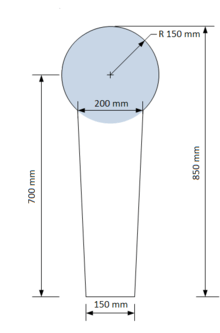
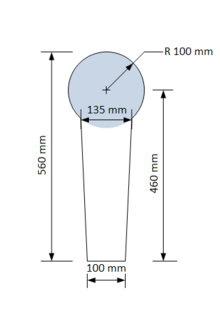
A typical course of fire has arrays of paper and/ or steel targets which the competitor must engage. Paper targets usually require two hits each, but sometimes more or less depending on the stage description. Steel plates need to fall when struck to be scored. The competitor is usually started by an audible signal from a shot timer, which also records the competitors time electronically by detecting the sound of each shot together with the time from the start signal. The time is stopped at the last shot, and is recorded to two decimal places (hundrerds of a second).
The scoring method is known as "Comstock" after its inventor Walt Comstock, and is done by adding the points on targets and subtracting penalties (if incurred) to get the points. The points are then divided by the time of the competitor to get a "hit factor", which is the ratio of points per second.
The competitor with the highest hit factor wins the stage and get the full total of Stage Points assigned to it. Competitors with lesser hit factors are awarded Stage Points according to their percentage hit factor compared to the stage winner.
The points per hit vary slightly depending on whether the competitor has declared minor or major power factor. A center hit for both minor or major is five points, but lesser scoring rings are rewarded more for major than minor with the A-C-D rings bein scored 5-4-2 for major and 5-3-1 for minor. A competitor who has declared minor must therefore shoot more "A" hits or shoot faster than one who has declared majorin order to make up the hit factor score for lesser hits.
| Scoring area |
Minor points |
Major points |
|---|---|---|
| A | 5 | 5 |
| C | 3 | 4 |
| D | 1 | 2 |
After the match is finished each competitor have their stage points totaled for all stages to calculate the final match standings, and the competitor with the highest match points wins the match. This method of comparing each competitor directly to the performance of the top competitor at each stage allows for a precise gradation of performances across the match, but requires a computer and software to do in a timely fashion.
Target arrangements
To achieve a varied, challenging and exciting sport there are no fixed target arrangements, distances or shooting programs, making the matches different each time. For instance targets may be placed between 10–30 m for handgun, 10–50 m for shotgun and 15–300 m for rifle. For rifle the recommended balance of target distances is that 30 percent of the targets are placed closer than 60 meters, 50 percent of the targets between 60 and 150 meters and 20 percent of the targets between 150 and 300 meters.
Approved paper and steel targets can be mixed in the same stage, and may be static, moving or partially covered by targets called no shoots that give minus points if struck by a bullet.
For paper targets, the IPSC Target in typical cardboard color is used throughout all the disciplines Handgun, Rifle and Shotgun, together with the 2/3 scaled down IPSC Mini Target which is used to simulate a full size target placed at a greater distance. Additionally the Universal Target can be used for rifle or shotgun, while the A3 and A4 paper targets are approved for shotgun matches only.
Steel targets are made of hardened (martensitic) steel. There are two standardized knock down targets, the IPSC Popper (85 cm tall, approximately 33.5 inches) and the 2/3 scaled down IPSC Mini Popper (56 cm tall, approximately 22 inches). Other metal plates can be in general shapes, and are often circles between 20–30 cm in diameter or squares between 15x15 cm to 30x30 cm for handgun, and circles between 15–30 cm in diameter or squares between 15x15 cm to 30x45 cm for rifle/ shotgun.
Short, medium and long courses
A match consists of a mix between short courses (lowest number of targets), medium and long courses (highest number of targets), and the approved balance is a ratio of 3 short courses to 2 medium courses and 1 long course (i.e. 6 short, 4 medium and 2 long courses for a level 3 match).
The number of targets dictate the available points for that stage, and therefore Long courses potentially can have a have great impact on the overall standings. Short courses have fewer points available, and tend not to be as critical for the overall standings. Short courses are often more technical, offer many different stage solutions, or include challenging elements such as "empty chamber" or "empty magazine well" starts, or "non-freestyle shooting" elements such as strong or weak hand only. Medium courses are something in between, while long courses will have the highest round count. Long courses tend to be more freestyle and straightforward as far as different stage solutions. The shooting challenges may still not necessarily be easy, and a match can be lost or won at a long course since there are so many points available.
| Discipline | Short Course | Medium Course | Long Course |
|---|---|---|---|
| Handgun, can reguire up to minimum | 12 rounds | 24 rounds | 32 rounds |
| Rifle, can reguire up to minimum | 5 rounds for Manual 10 rounds for Semi |
10 rounds for Manual 20 rounds for Semi |
20 rounds for Manual 40 rounds for Semi |
| Shotgun, can reguire up to minimum | 8 rounds, maximum 12 scoring hits |
16 rounds, maximum 24 scoring hits |
28 rounds, maximum 32 scoring hits |
To encourage movement, some special conditions apply to organizers for course construction.[4] Normally a competitor must not be able to shoot all targets in a course from any single location or view, and:
- For Handgun, a course must not require more than 9 scoring hits from any single location or view.
- For Shotgun, a course must not require more than 8 rounds to be shot from any single location or view. Also, an unloaded gun can not be stipulated as a start condition if the course requires 24 or more rounds to complete.
- For Rifle, a course should not normally require more than 5 scoring hits from any single location or view if one hit is required per target, or 10 scoring hits if 2 hits are required per target. However, if the targets are placed at a distance over 100 meters, the number of required hits from a single location or view can be increased to 8 and 16 respectively.
Safety
The safety of all competitors, officials and spectators are always of the highest importance in competitions. Eye and ear protection is mandatory for both competitors and spectators. Firearms are kept unloaded until on the firing line under the direct supervision of a Range Officer, and can otherwise only be handled in designated safety areas. The safety area contain a direction with a secure backstop where competitors can handle unloaded firearms for example for packing or unpacking, holstering, cleaning or repair, dry firing or training with empty magazines. Handling of ammunition is expressively prohibited within the safety areas, including any dummy rounds. Outside the safety area ammunition can be handled freely to load magazines, but firearms may only be handled under the direct supervision of a Range Officer. The strict separation of firearms and ammunition prevents accidents like accidental discharge (AD). Violators will be prosecuted as a rule, with immediate disqualification and exclusion from the competition.
Competitive divisions
In the beginning, IPSC was fired with whatever firearm the competitors chose. After a relatively short period, it became clear that equipment mattered, and equipment divisions were thus designated. All divisions fire the same stages, on the same days, as all other divisions, in a match. However, when calculating match standings, only sivisional stage scores are compared. Thus, the top competitor in Open on a stage is the measure for all other Open competitors, the best Standard competitor is the measure for all other Standard competitors and likewise for all other divisions.
Handgun
The minimum caliber is 9x19 mm for all handgun divisions. During competition the handgun must be worn in a holster securely attached to the competitor's belt. The holster needs to cover the trigger guard, the heel of the gun needs to be above the top of the belt and the belt has to be attached through at least three belt loops. Men must wear the holster, magazine holders etc. in the belt at waist level, while female competitors may choose to wear their equipment either at hip or waist level. During competition the position of the holster, magazine holders etc. can not be moved or adjusted from stage to stage. For all divisions except Open and Revolver the foremost portion of the handgun and all magazines must be placed behind the hip bone. Race holsters are permitted in all divisions
- Open
Open division is the handgun equivalent to the Formula 1 race car where most modifications are permitted to achieve a faster and more accurate gun. It's the only division which permits optical and electronic sights (such as red dot sights) and recoil reducing muzzle brakes (also called compensators).[5] The division facilitates the highest magazine capacity, placing a restriction of 170 mm maximum overall length measured at the rear of any magazine. Shorter magazines, i.e. 140 mm, are also popular because of easier handling and often more reliable feeding, leaving the competitor a choice of equipment according to the stage at hand.
Open and Revolver are the only two divisions where 9 mm bullets (.38") can be used to achieve major scoring, and hence .38 Super (or some variant) or 9x19 mm loaded to major power factor of 160 (3.16 Ns) are popular cartridges for the pistols in Open. The 9 mm caliber cartridges provides higher gas pressures and better magazine capacity over 10 mm calibers. Open handguns are often expensive custom builds with parts and features specifically designed for competition, and with the maximum magazine length of 170 mm some 9 mm/ .38 Super magazines can hold up to 28 or 29 rounds.[6]
The Open division was formally adopted at the General Assembly following the 1992 European Handgun Championship in Barcelona, Spain, and became a recognized division starting in 1993.[7] Any handguns complying with the previous rules were included, for instance there was placed no restriction on handgun size or type of sights. Later the 170 mm maximum length was introduced.
- Standard
Standard division allows any handgun that fits inside the IPSC box, and most modifications are permitted (except optical sights or compensators). Light match triggers are common, and modifications such as slide rackers, thumb rests ("gas pedals") and grip tape on the slide can sometimes also be seen. The IPSC box has internal dimensions of 225 x 150 x 45 mm[5] in length × height × depth with a tolerance of +1 mm, -0 mm (approximately 8.86 x 5.91 x 1.77 inches). The handgun must fit with the slide parallel to the longest side of the box and hammer cocked if applicable. The handgun must fit the box with any of its magazines inserted, which means that for instance on 2011 pattern pistols either 124 or 126 mm magazines usually will give the maximum capacity and still fit the box.
Minimum caliber for minor scoring is 9x19 mm loaded to a power factor of 125 (2.47 Ns) while minimum caliber for major scoring is a 10 mm (.40") cartridge loaded to a power factor of 170 (3.36 Ns), making for an interesting choice between minor and major scoring taken in mind the differences in recoil, magazine capacity and scoring points. An example of differences in magazine capacity depending on caliber can be seen when comparing stock 126 mm STI double stack magazines, which according to the manufacturer yields a capacity of either 12 rounds of .45 ACP, 14 rounds of .40 S&W or 17 rounds of 9x19 mm. It is common belief that major scoring using the .40 S&W will give better scores for most competitors over the 9 mm, but at the cost of more expensive ammunition. Magazine capacity can be further increased using aftermakert springs, followers and basepads as long as they still fit the box.
The Standard division was formally adopted at the General Assembly following the 1992 European Handgun Championship in Barcelona, Spain, and became a recognized division starting in 1993.[7] One of the intentions of the Standard division was to create an own division for more "stock" firearms, since it up to then had been no equipment divisions, and the sport had started to become dominated by custom built race guns with compensators and optical sights. However, the Standard division was later criticized for also having become a "race division" somewhat like Open, dominated by custom built guns and specialized gear. Major caliber .40 S&W dominates, since it is seen as a much better alternative scoring-wise, but is more expensive than regular minor scoring 9x19 mm (price difference varies, but usually 50-60% more expensive). Also, from a practical standpoint, the .40 S&W can be difficult to obtain when travelling to international matches, while the 9x19 mm round on the contrary is perceived as affordable and available all around the world. This made way for the Production division starting in 2000, which has minor scoring only, allows fewer modifications and has a common magazine limit of 15 rounds.
- Production
Production division is the most popular division as of 2016. The division allows very few modifications and is limited to typical "off the shelf" service pistols which has to be explicitly approved and listed on the IPSC Production Division List. The handgun must be double-action (DA/ SA, DAO or striker fired), and the first trigger pull must be a double action of at least 2.27 kg (5 lbs). Maximum barrel length is 127 mm (5 inches).
Production is the only division with minor scoring only, which means that anyone can be competitive with affordable and readily available 9x19 mm factory ammunition, without having to worry about handloading to make major. Together with (in general) affordable handguns, Production therefore makes for a popular division. Different models of handguns have variance in magazine capacity, but this is evened out by limiting competitors to load their magazines to a maximum of 15 rounds (15 in each magazine plus 1 in the chamber).
Permitted modifications are limited to the application of grip tape in limited areas around the grip, replacement of sights that do not require gunsmithing to be installed (i.e. milling to the slide) and the replacement of internal components only available as a factory option from the original manufacturer. After-market magazines are allowed. Minor polishing and fitting of trigger components is permitted. Note that there are differences in approved handguns for IPSC Production division and USPSA Production division, as well as permitted modifications.
The Production division was introduced at the General Assembly after the 1999 Handgun World Shoot in Cebu, Philippines,[8] and became a recognized division starting in 2000.
- Classic
Introduced in 2011, the Classic division was modelled after the USPSA Single Stack division and is limited to handguns visually resembling the single stack 1911 form. The handgun with any of its magazines inserted has to fit inside the IPSC box. The competitor can choose between maximum 8 rounds per magazine for major scoring or 10 rounds per magazine for minor scoring. Minor scoring can be achieved with a 9 mm projectile loaded to a power factor of 125 (2.47 Ns), while major scoring requires a 10 mm or larger projectile loaded to a power factor of 170 (3.36 Ns).[5]
Handguns must have a one piece metal frame, slide with stirrup cuts and the dust cover (with or without an accessory rail) can have a maximum length of 75 mm from the leading edge to the rear of the slide stop pin. Magazine wells cannot exceed a maximum outside width of 35 mm. Permitted modifications are shaped slides (i.e. flat-top or tri-top), shaped trigger guards (i.e. squared or undercut), bob-tail backstraps, bull or coned barrels, external extractors, finger-grooves (machined, add-on, wrap-around etc.), custom magazine release buttons, triggers, hammers, single/ ambidextrous thumb safeties, any iron sights, extended slide lock levers and thumb shields provided they do not act as a thumb rest. Cosmetic modifications are permitted.
Prohibited modifications / parts are slide lightening cuts, weak hand thumb rests and slide rackers.
- Revolver
In the Revolver division double action revolvers of any capacity can be used, but a maximum of 6 rounds can be fired before a reload is required. Muzzle brakes or optical sights are not permitted. Competitors can have any caliber 9x19 mm or larger, and may declare major with a 9 mm (.38") bullet loaded to a power factor of 170 (3.36 Ns).[5] .45 ACP is popular cartridge due to easier insertion of moon clips/ speedloaders. There are currently trials on changing the maximum rounds fired before a reload to 6 for major and 8 for minor. The Revolver division was introduced at the General Assembly after the 1999 Handgun World Shoot in Cebu, Philippines, and was a recognized division starting in 2000, initially under the name "Revolver Standard" before it was renamed to "Revolver" around 2009.
- Modified
Now obsolete, the Modified division was sort of a mix between Open and Standard. The division originated from when a handgun in the Standard division only had to fit inside the box, and some competitors modified their handguns heavily to make it fit inside the IPSC-box while fitted with compensators and optical sights. The Modified division was formally adopted at the General Assembly following the 1992 European Handgun Championship in Barcelona, Spain, and became a recognized division starting in 1993.[7] Handguns were allowed to have compensators and optical sights as long as they would fit in the IPSC box with any of its magazine inserted. The division saw some use in southern Europe, but was otherwise not very widespread, and was retired after the 2011 World Shoot XVI in Rhodes, Greece. Competitors with Modified handguns would then afterwards compete in Open.
-

Single Action 2011-pattern pistols, like the STI Edge, are common in the Standard division.
-
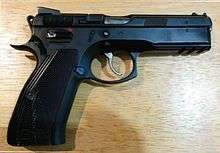
Double Action / Single Action CZ 75 variants on the IPSC Production Division List are popular alternatives for Production division.
-
Striker fired pistols on the IPSC Production Division List, like this Glock 17, are also popular in Production division.
-
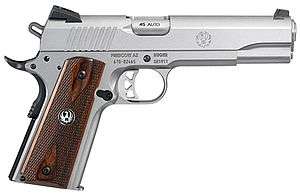
The Ruger SR1911 is an example of a M1911-pattern pistol, which would be approved for Classic division.
-
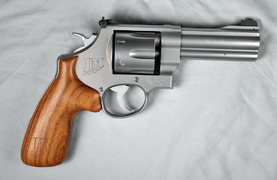
The .45 ACP Smith & Wesson Model 625 is an example of firearm suited for Revolver division.
-

Measurements of the "IPSC box" used for compliance check with the Handgun Standard and Classic divisions.
Rifle
Important elements in rifle include the use of prone, off hand and supported shooting positions. Starting position is usually with the butt of the rifle touching the hip. Knowledge of the firearms ballistics is a key element to succeed at the long range targets.
There is no minimum caliber, but the ammunition has to make a power factor of 150 (2.96 Ns) for minor or 320 (6.32 Ns) for major scoring. Since two hits per target is normally required, rifles with minor power factor calibers dominate on the shorter ranges in both of the Semi Auto divisions due to less recoil and shorter recoil impulse. Ammunition loaded to major power factor has more recoil and a longer recoil impulse, but have the advantage of better ballistics at long range targets. Major scoring is more competitive in the manual divisions since normally only one hit is required per target, lessening the importance of a small recoil impulse.
In the beginning competitions were fired with whatever rifle the competitors chose, and while the type of rifles mostly have remained the same sighting systems have changed a lot. For a while rifles equipped with optics and iron sights competed side by side, but were divided somewhere around the 2000s into an Open division for optic sights and a Standard division for iron sights. Open and Standard were the only two rifle divisions until the 2004 season when similar divisions were introduced for manually operated mechanisms. The Open and Standard division was then renamed to Semi Auto Open and Semi Auto Standard, while the new manual divisions was named Manual Action Open and Manual Action Standard. Around 2011 a provisional division named "Manual Action Standard 10" was approved for evaluation as a testing ground for development of the Manual divisions.
- Semi Auto Open (SAO)
Semi Auto Open is the Formula 1 division for self-loading rifles. Optical sights are allowed together with bipods and muzzle brakes.[9] Bipods can be taken on and off during a stage, and on some stages it can even be advantageous to switch between different bipod sizes. Many top competitors use rifles with 46 cm (18") barrels in order to run the longer rifle length gas system and achieve a softer recoil impulse. An adjustable gas system is popular. Some also use low mass bolt carriers and buffer weights, which may however cause reliability issues if not tuned correctly.
Scope sights with a variable magnification from 1x and up are popular, with illuminated 1-4 or 1-6 scopes being the most popular. Some use reticles with marked hold overs to compensate for bullet drop on long range targets, while others prefer reticles with a simple dot and crosshair and choose to dial long range adjustments on the turrets instead. To avoid having to adjust magnification up and down when transitioning between several long and short range targets during the same stage, some combine a scope with a 45 degree side mounted red dot optic, but the effectiveness of this is debated and there are both top competitors who use it and not.
Rifles with non-magnified red dot sights as the primary optic also compete in Open and are very competitive at short ranges, but the lack of magnification is a big disadvantage at longer ranges.
- Semi Auto Standard (SAS)
The Semi Auto Standard division is limited to iron sights only, bipods are not allowed and muzzle brakes have to be within the maximum dimensions of 26x90 mm (1x3.5 in).[9] A long sight radius is desirable as it helps even target and sight focus, and thus iron sighted rifles often have longer barrels with the front sight attached to the end of it. Many Standard top competitors use the longer 50 cm (20") barrel over the 46 cm (18") to achieve longer sight radius. Any iron sights can be used, and both "globe" and "post" front sights are popular.
- Manual Action Open (MAO)
The manual divisions are limited to manual action types. Manual Action Open allows optical sights, muzzle brakes and bipods, and is the only manual division with no magazine capacity limit.[9]
- Manual Action Standard (MAS)
Manual Action Standard is limited to iron sights only, and no muzzle brakes or bipods are allowed. Magazine capacity is limited to 6 rounds (5 in the magazine plus 1 in the chamber).[9]
- Manual Action Standard 10 (MAS10)
MAS10 is a division under evaluation, and sort of a crossover between MAS and MAO, being limited to iron sights only, a magazine capacity of 11 rounds (10 in the magazine plus 1 in the chamber) and factory fitted muzzle brakes only.[9]
-
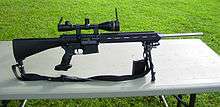
Semi Auto rifles fitted with optics compete in Semi Auto Open (SAO).
-

Iron sights are the trade mark of the Standard divisions, both in Semi (SAS) and Manual (MAS).
-

Bolt action rifles with iron sights, like this Tubb 2000, would be suited for the Manual Action Standard division.
-

This Ruger Gunsite Scout Rifle could be used in the Manual Action Open division.
-

Lever action rifles like this Marlin 336W is also an example of a Manual Action rifle.
Shotgun
The minimum caliber for shotguns are 20 gauge, and starting position is usually with the shotgun in one hand and the butt of the shotgun touching the hip. There is only one power factor of 480 (9.48 Ns), and all targets are scored as major. Different options on shotgun chokes and ammunition (from different pellets sizes and up to slugs) makes for interesting choke and ammunition choices based on the stage at hand. All divisions have limits of the number of shells loaded at the beginning of the stage, but the limits are removed after the start signal. For instance some may choose to run 10 or 11 round tubes in the Standard division which is limited to 8 rounds in the tube at the start signal.
- Open
The Open division allows optical sights, muzzle brakes, and detachable magazines or the use of speed loaders for internal magazines. The maximum overall length of the shotgun is 1320 mm (approximately 52 in) measured parallel to the barrel.[10] Detachable magazines must not contain more than 10 rounds at the start signal, while shotguns with fixed magazines may have an initial load of 14 rounds. After the start signal detachable magazines can be loaded up 12 rounds, while there is no limit for tube magazines.
- Modified
The Modified division allows muzzle brakes, but is limited to internal magazines and iron sights. The maximum overall length of the shotgun is 1320 mm.[10] Modifications of the floor plate to facilitate loading is permitted, given that the modification doesn't exceed 75 mm in length or protrudes more than 32 mm from the shotgun frame in any direction. Maximum 14 rounds can be loaded at the start signal (13+1, 13 in the tube plus 1 in the chamber), but more can be loaded after the start signal.
- Standard
The Standard division is limited to iron sights, and muzzle brakes are not allowed. The shotgun model has to be factory produced of at least 500 units.[10] Maximum 9 rounds can be loaded at the start signal (8+1, 8 in the tube plus 1 in the chamber), but more can be loaded after the start signal.
- Standard Manual
The Standard Manual division is the only shotgun division limited to manual actions. Limited to iron sights and no muzzle brakes, and the shotgun model has to be factory produced of at least 500 units.[10] Maximum 9 rounds can be loaded at the start signal (8+1, 8 in the tube plus 1 in the chamber), but more can be loaded after the start signal.
-

Shotguns with detachable magazines, like this Vepr-12, is only allowed in Open division.
-
.jpg)
Since this shotgun has an internal magazine, compensator and iron sights, it could be used in the Modified division.
-
.jpg)
The upmost pump shotgun is approved for Standard Manual division, while the semi Auto Shotgun in the middle is approved for the regular Standard division.
-
Double-barreled shoguns are also approved for Manual Standard division.
Tournaments
Multi Gun matches are called tournaments and can include a combination of the three disciplines handgun, rifle and shotgun in the same match. The default Grand Tournament divisions are:
| Tournament Division | Handgun | Rifle | Shotgun |
|---|---|---|---|
| Open | • Open, • Standard, • Production, • Classic or • Revolver |
• Semi Auto Open, • Semi Auto Standard, • Manual Action Open or • Manual Action Standard |
• Open, • Modified, • Standard or • Standard Manual |
| Standard | • Standard, • Production, • Classic or • Revolver |
• Semi Auto Standard or • Manual Action Standard |
• Standard or • Standard Manual |
| Production | • Production, • Classic or • Revolver |
• Manual Action Standard | • Standard Manual |
Match organizers may declare their own specific Grand Tournament divisions, for instance
| Tournament Division | Handgun | Rifle | Shotgun |
|---|---|---|---|
| Open | • Open | • Semi Auto Open | • Open |
| Modified | • Standard | • Semi Auto Open | • Modified |
| Standard | • Standard | • Semi Auto Standard | • Standard |
| Production | • Production | • Manual Action Open | • Standard Manual |
Other
In addition to the main disciplines (handgun, rifle and shotgun) there are also some supplemental disciplines:
- Mini Rifle is for small caliber rifles (.22 LR only) and competitions are mostly held indoor in the winter as training in the off-season.
- Action Air is for airsoft handguns, and enjoys popularity in countries where civilian ownership of firearms are restricted. Action Air is also used in the off-season in other countries as an affordable and easily available training tool because there is no need for a shooting range (competitions can for instance be held at an ordinary gym)
Competitor ranking
The Official IPSC Classification System (ICS) gives competitors the ability to rank both nationally and internationally based on performance. For this purpose, special classification matches with standard exercizes are used, where the competitor's hit factor is compared to the highest for that ICS stage. The ICS is dynamic and classifications may change based on competitor scores. A competitor achieves initial classification after 4 scores, and classification will be based on the average of the 4 best scores of the most recent 8 submitted.[11] The competitors can achieve a rank of either Grand Master, Master, A, B, C or D Class in each division.
| Class | Percent |
|---|---|
| Grand Master | 95-100% |
| Master | 85-94.9% |
| A | 75-84.9% |
| B | 60-74.9% |
| C | 40-59.9% |
| D | 2-40% |
IPSC Rating.com is a third party rating service based on performance in actual competitions and advanced rating algorithms. Results from IPSC level 3, 4 and 5 matches plus major USPSA matches are processed, with the last IPSC World Shoot as the most trusted and representative source.[12] Scores of competitors in other matches are compared to known "key competitors" who are already rated to achieve global rating percents. To be ranked one must compete in at least two level 3 matches, and old results will expire if they are not updated with following matches.
Match personnel
The International Range Officers Association (IROA) is a part of IPSC with the responsibility to train and certify their own dedicated range officials, who are responsible for conducting matches safely, fair and according to the rules. In addition, each IPSC region have their own National Range Officers Institute (NROI) under the IROA. In a match range officials from IROA and NROI can work alongside in the ranks:
- Range Officer (RO) - The Range Officer gives the competitors stage briefings, issue range commands and follows the competitor through the conduction of the stage to monitor time, scores and safe firearms handling.
- Chief Range Officer (CRO) - In case there are several Range Officers, a Chief Range Officer will be assigned to have the primary authority over the particular course. Like the RO, the CRO will oversee fair and consistent application of the rules.
- Range Master (RM) - The Range Master has the overall authority over the entire range during the match, including all Match Officials and the overall safety.
The Match Director (MD) handles the overall match administration before and during the match, including registration, squadding, scheduling, range construction and coordination of the staff. The Match Director doesn't have to be an NROI or IROA Official. The Stats Officer (SO) is another important role with the responsibility to collect, sort and verify the final results.
Match levels
Competitions are held at all levels from club matches and up to the world championships. Level 3 matches and up require official IPSC pre-approved match level sanctioning in regards to courses, IROA-range official etc.
- Level 1: Club matches
- Level 2: Matches open to participants from different clubs
- Level 3: Regional matches, i.e. national championships
- Level 4: Continental championships, i.e. the European or Pan-American Championship
- Level 5: The World Shoots
World Shoots
The World Shoots are the highest level shooting matches within IPSC.[13] Held since 1975,[14] it is a multi-day match where the best IPSC shooters from around the world vie for the title of World Champion. The Handgun World Shoots consists of at least 30 separate courses of fire, while the Rifle and Shotgun World Shoots consists of at least 25 separate courses of fire.
Currently the championships are held with three year cycles for each of the disciplines Handgun, Rifle and Shotgun, meaning that since the last Handgun World Shoot was held in 2014, the next Shotgun World Shoot will be held during 2015 and the next Rifle World Shoot in 2016.
Arranging matches
Stage design
Sketches for stage construction can for instance be drawn by hand or with 3D modeling software like SketchUp.
Electronic scoring
Matches can either be scored on paper and manually transferred to the official IPSC Match Scoring System (WinMSS), or can be scored directly on electronic devices like smartphones and tablets with third party scoring systems like Shoot'n Score It or PractiScore.
See also
References
- ↑ Columbia Conference Minutes
- ↑ "What Is IPSC", accessed August 17, 2007.
- ↑ IPSC.org :: Regions
- ↑ IPSC :: Rules FAQ
- 1 2 3 4 IPSC :: The Handgun Divisions List
- ↑ Infinity Firearms - Magazines
- 1 2 3 Diligentia - Officiel Newsletter of IPSC Canada, No 2 1992
- ↑ Twenty-Third IPSC General Assembly Cebu, Philippines, October 1999
- 1 2 3 4 5 IPSC :: The Rifle Divisions List
- 1 2 3 4 IPSC :: The Shotgun Divisions List
- ↑ IPSC.org :: Classifications
- ↑ IPSC shooters rating - About
- ↑ IPSC :: IPSC Match Ratings
- ↑ IPSC :: History of Champions
External links
- The official webpage of the International Practical Shooting Confederation
- The official Facebook page of the International Practical Shooting Confederation
- ipscrating.com - IPSC shooters rating